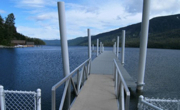 The world appears far from getting a grip on world oil-fueled shipping. The ongoing consequences are well known, but periodic disasters get our attention. A collision and spill of at least 168,000 gallons of marine fuel happened on March 22 near Houston, Texas. It closed a major petrochemical shipping route. Each spill, we have seen over the decades, does practically nothing to stop the next one, and the next one. News items surface for a couple of days, only to disappear unless there was dramatic loss of human life. The public's glimpse of every major pollution event is fleeting, while the polluting interests and impotent "relevant" government agencies carry on. "Galveston Bay in Texas has averaged 285 oil spills per year since the late 90s... fifty billion gallons of oil are transported through the gulf annually," said Shipping & Logistics Industry Today/Resource Investing News on April 11.
The clean-ups make GDP look all the better, and benefit the petroleum industry indirectly: the large number of motor boats, motor vehicles and plastic suits and bags -- more pollution of course -- is good business. It is ironic that "dirty" petroleum is scrubbed from "clean" (toxic) petroleum: the plastic motor yachts that belch exhaust (as pictured here). An estimated 219,025 pounds of oiled material had been bagged through April 5. These pictures from late March in the Houston and Galveston area are from the official oil disaster website for the "Texas City 'Y' Spill": 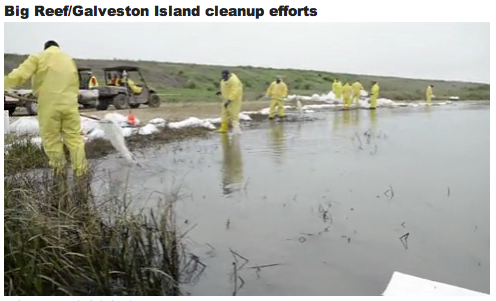 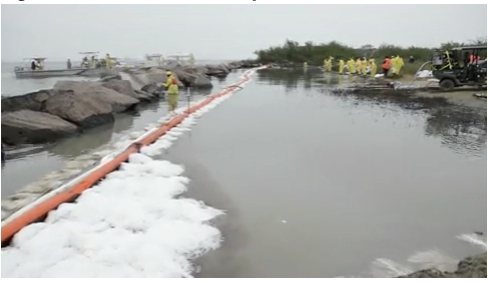 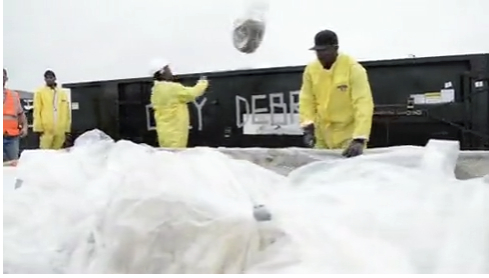 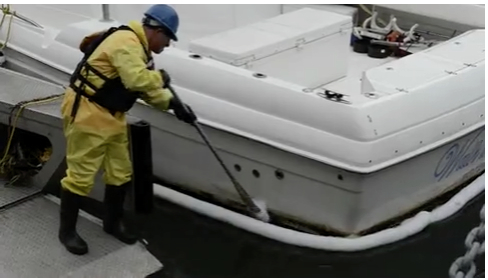 Hundreds of thousands of perhaps 330 kinds of birds fly along the Texas coast where they feed and rest during migration. It can be a very dangerous time for them, as they must gain enough body-weight to reach their destination -- for some it's as far north as the Arctic. The bird in the picture at top was unlucky enough to meet up with the March 22 marine-fuel spill into Galveston Bay. This is the peak of the migration period for birds in the region. The oyster beds are natural filter systems in estuaries, but can they filter bunker oil? An on-the-scene reporter for Sail Transport Network gives his observations and raises several other questions, at the bottom of this webpage. While stronger regulations for the maritime-petroleum industries, and rapid, thorough clean-ups are essential, the public is led to believe that there is nothing that can change the status quo. Recall President Obama's tough talk about making BP pay for the 2010 Gulf blowout and contamination -- he made no mention of ceasing current practices in wasteful consumption to cut petroleum dependence. While thousands of polluting ships ply the seas -- over 70,000 ocean-going ships, not including barges such as this one that emptied about one fourth of its heavy bunker fuel cargo -- the alternative to oil pollution, i.e., wind energy transport (i.e., sailing without oil), is almost never mentioned. But it has been advancing steadily to the point that it should be the solution placed into the markets starting today. It cannot replace the huge volume of world trade done via oil, but much essential trade could be managed with sail power. Why not, when today’s large cargo vessels’ speed has dropped below that of the clipper ships of the 19th century? The typical objection to this "romantic" and "impractical" solution is that we would have to forego the present volume of consumer goods. But we must also start embracing a rational scale of world trade and consumption. The reasons are -- not necessarily in this order, depending on one's priorities -- ecological, energy-resource limits, and economic. "What, economic you say?" Yes, the gross inefficiencies of the heavily subsidized yet struggling oil extraction industry assure that almost everyone's complicity in frying the planet translates to a much constrained economic and ecological future. One of the ships in the Houston collision was 585 feet long. Such volume of trade is unsustainable, and ultimately very unhealthy for any local economies dependent on their local ecosystems and food supply -- and what local economy is really exempt, soon enough? 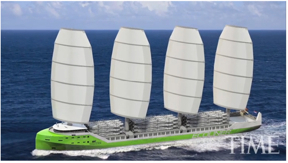 Alternative: planned Ecoliner, courtesy Time video
A steadily advancing example of the future now is Greece. Until the "mortgage crisis" hit, Greece had been "growing" -- as long as massive debt and subsidized energy made overconsuming enticing and justifiable. Now the façade of conspicuous middle-class wealth has started to crash down, revealing government to be close to irrelevant. Greeks are pursuing localized strategies to survive, such as eliminating the Middle Man, going "back to the land," doubling up households, and refraining from using expensive heating oil and electricity. Fitting into the new reality is sail transport, whose revival has begun with baby steps, intent on emulating recent developments in northern Europe (see links at bottom). The 70,000 conventional cargo ships typically move, for example, an astronomical number of plastic Chinese basketballs, millions of tons of food that should instead be grown much closer to the point of consumption, millions of cars to individual polluters, and also ship (via tanker) billions of gallons of oil itself -- all to keep the corporate economy humming. Yet, just 16 (sixteen) of those 70,000 ships belch into our air as much sulfur and other pollutants as all the world's cars. Although this fact has been known for years, the shipping industry still eludes adequate pollution regulations in these times of climate change and steps toward renewable energy reliance. 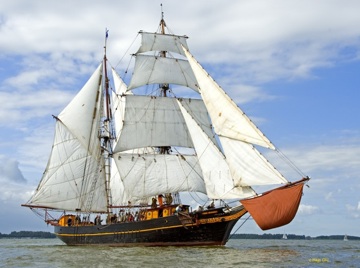 Alternative: the Tres Hombres, sailing cargo transatlantic regularly, no engine
The maritime industry has put forward an approach to its air pollution: it aims to deal with the sulfur emissions and the deaths it causes globally by installing scrubbers on ships and accepting low-sulfur regulations coming down the pike. However, this approach, loved by both industry and government, can succeed only in creating an improvement equivalent to only perhaps 26 ships spewing out into the air as much sulfur and other pollutants as all the world's cars. If that were not myopia, the shipping industry is telling itself that there will be decades of plentiful oil. An oil crisis, such as the two in the 1970s, is not on their radar. The main alternative fuel being touted and planned for is liquified natural gas (LNG ) -- which cuts only 25% of the CO2 emissions from heavy fuel oil relied upon today. Sailing is not being considered enough within the industry, except by a few visionaries in the EU (see link at bottom). This neglect is due to the fact that the shipping industry had a production crisis similar to the mortgage crisis -– but the high inventory of old and polluting ships does not justify the lagging behind of clean energy innovations in the industry. While business-as-usual chugs along on our blue/oily planet, there are the inevitable spills, explosions, derailments and everyday waste caused by shipping by oil. Most recently the Houston Shipping Channel’s fender-bender showed that all the sophisticated technology and training for safety does not prevent ecological and public health disasters. (See news summary and links below.) Surely, with inevitable human error and the ongoing poisoning of the environment by petroleum, it is time to think outside the box. Perhaps the chief obstacle in doing so is the long identified problem of externalities: there is no profit in saving ecosystems or sparing people's lungs from soot, sulfur and poisoned water; there is no cost for abusing the environment and the public. The shipping industry demands -- as does the entire corporate economy and its compliant governments -- business as usual for "endless" growth in trade. What about Peak Oil? Diminishing net energy from petroleum extraction? Unending subsidies for petroleum industries that conceal the true costs of petroleum products purchased by billions of consumers? Persistent externalizing of environmental and public health costs? -- forget about them all, and ignore the sail transport option, if your investment is in modern oil boats; i.e., conventional cargo vessels. However, this standard attitude is starting to waver and be questioned. 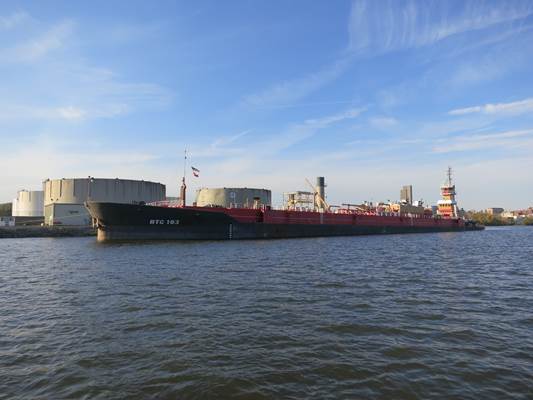 A similar oil barge, Port of Albany
Fortunately, the sail transport movement is on the rise. For example, the 32-meter schooner-brig the Tres Hombres is now completing its last leg across the Atlantic back home to Holland, on its fifth voyage bringing rum, chocolate, cacao and coffee from the Caribbean. Plans for more sailing ships are moving along in much of Europe. No doubt the U.S. will eventually follow suit, if it wants to stay at the helm of innovation and clean energy solutions. Now for more insight and details on the Houston bird sanctuary oil spill. This oil was ship fuel for other ships. As soon as we heard about the disaster, the Sail Transport Network (STN) called upon the Houston Audubon Society to join efforts to support clean, renewable-energy shipping. Our Houston area STN correspondent was activated and has been a great help. * * * "A barge carrying about 900,000 gallons of the heavy oil collided with a ship Saturday in the busy Houston Ship Channel, spilling as much as a fifth of its cargo into one of the world's busiest waterways for moving petrochemicals" -- aol.com/AP, March 24, 2014. 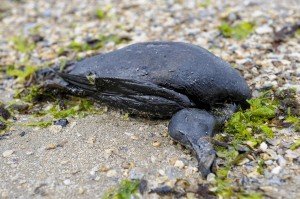 by Chase Fountain of TPWD state agency
The Houston Chronicle published on April 5th, "A portion of the oil was blown into the Gulf of Mexico and drifted south to the Matagorda Island area... So far, 258 oiled birds have been recovered, only eight of them alive, said [the] U.S. Coast Guard..." See 3 rehabbed birds return to wild after Galveston oil spill, by Craig Hlavaty. It was and remains a significant event for the Houston/Galveston economy. Here is the newspaper's list of Related Stories as of April 5:
The official clean-up website www.texascityyresponse.com issued a release on April 6: "Response efforts continue on South Matagorda Island, Mustang Island and Padre Island National Seashore" For those humans touching the oil, a scary medical advisory was issued on the official clean-up website regarding contact with RMG 380 Marine Fuel The official link for the spill includes a map that seems to hope oil will not drift: "Safety Zones". Note the logo for Kirby, the oil-spiller, on the map. The logo is also on the Coast Guard and Unified Command websites. This is like having the BP logo on the U.S. Environmental Protection Agency website (if it's not there already). 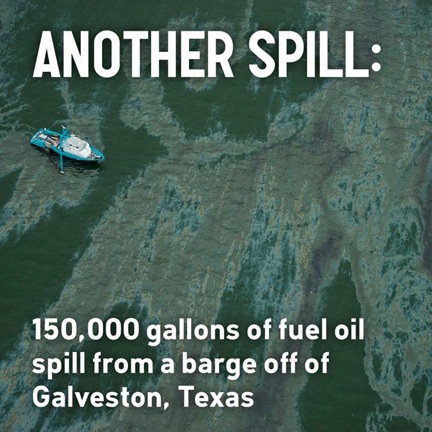 Courtesy 350.org
The UK's Sky News reported on March 23, 2014, that a big clean-up operation has begun after a barge carrying nearly one million gallons of thick oil collided with a ship in a popular bird sanctuary. The Coast Guard said it is not known how much "special bunker" has spilled in Galveston Bay, Texas. At least one of the vessel's tanks - which each carry up to 168,000 gallons of oil - was holed, and a large slick was visible on the surface. The barge is owned by Kirby Inland Marine, and was being towed from Texas City to nearby Bolivar when it collided with the 585ft-long ship Summer Wind. The report at news.sky.com continued,
350.org commented on its Facebook Page on March 25 about "ANOTHER spill" --
"This one is bigger. And in the already wrecked Gulf of Mexico. And it's a heavy oil that might sink." Readers were referred to the Notes from a Sail Transport Network observer near Houston:
Shipping & Logistics Industry Today website: einnews.com. Article: Oil Transportation Through Texas Gulf in the Spotlight after Galveston Bay Spill, by Resource Investing News, April 11, 2014 * * * * * Learn about the Ecoliner to be constructed and launched through the EU project the SAIL consortium in the North Sea.
Read about the Fair Transport company's Tres Hombres ship at Website for the Sail Transport Network  |
|||
 |
||
|
|
